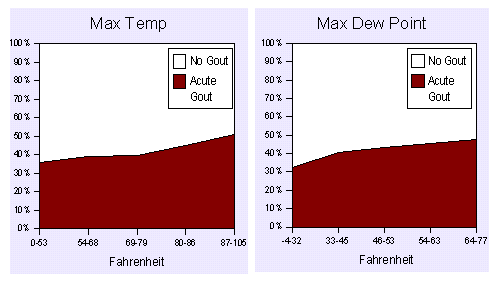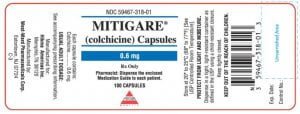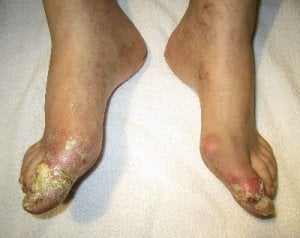A gout causes study presented at the 70th annual meeting of the American College of Rheumatology reveals a link between gout and the weather. So if you are looking for unusual reasons for gout, you might need to look at the weather forecast.
High Humidity and High Temperature Increase the Risk of Recurrent Gout Attacks:
The Online Case-crossover Gout Study
This study by YQ Zhang, CE Chaisson, CA Chen, TE McAlindon, and DJ Hunterree states:
“While dehydration has long been considered a potential trigger for recurrent gout attacks, few studies have examined the relation of risk factors that may cause dehydration to the risk of recurrent gout attacks. In hot and humid weather individuals can lose body fluids through perspiration. Thus, serum uric acid levels may increase due to reduced uric acid excretion.”
197 gout sufferers logged details of gout attacks and gout-free days. The results indicate a strong correlation between both increased temperature and increased humidity. I’ve charted the figures from the study:-

For further information see the abstract of this gout study below, including the data from which I built my graph.
The authors conclude:
“Our results demonstrate that high temperature and high humidity are both associated with an increased risk of recurrent gout attacks. Under such weather conditions, subjects with gout may need to increase fluid intake to replace volume depletion.”
This reinforces how to avoid one of the reasons for gout we already know about – drink plenty of water (and not just when it’s hot or humid).
High Humidity and High Temperature Increase the Risk of Recurrent Gout Attacks: The Online Case-crossover Gout Study
While dehydration has long been considered a potential trigger for recurrent gout attacks, few studies have examined the relation of risk factors that may cause dehydration to the risk of recurrent gout attacks. In hot and humid weather individuals can lose body fluids through perspiration. Thus, serum uric acid levels may increase due to reduced uric acid excretion.
We conducted a case-crossover study to assess a set of putative risk factors, including climatic factors, triggering recurrent gout attacks. Subjects who had experienced a gout attack within the past year were recruited online and followed-up prospectively. Participants were asked to log onto a study website when they experienced a gout attack. Risk factors on each day over the two-day period prior to an acute gout attack (hazard period) were assessed using the online questionnaire. The same questionnaire was used over each of two days during an intercritical period (control period). We obtained climatic data (i.e., temperature, barometric pressure, humidity, precipitation) from the National Oceanic and Atmospheric Administration website for the corresponding hazard and control periods according to the zip code provided by the participant. We examined the relation of each climatic factor to the risk of recurrent gout attacks using a conditional logistic regression model adjusting for alcohol consumption, purine intake and diuretic use.
197 subjects completed both control and hazard period questionnaires during the follow-up period. 94% of the subjects had a confirmed history of gout according to ACR criteria. Participants were predominantly male (80.2%) and White (88.0%). Most participants had a college education (57.3%). The median time between the onset of a gout attack and logging on to the website was 2 days. High temperature and high humidity were both strongly associated with an increased risk of recurrent gout attacks (Table). Compared to the lowest quintile of maximum daily temperature (0-53 °F) over the last 2 days, the odds ratio for recurrent gout attacks for the highest quintile of maximum daily temperature (87-105 °F) was 2.0 (95% CI: 1.1-3.5) (P for trend =0.033). Compared to the lowest quintile of humidity (dew point:-4-32°F), the odds ratio for recurrent gout attacks for the highest quintile of humidity (dew point: 64-77°F) was 2.1 (95% CI: 1.2-3.7). (P for trend = 0.018). No such relation was observed for barometric pressure or precipitation.
Our results demonstrate that high temperature and high humidity are both associated with an increased risk of recurrent gout attacks. Under such weather conditions, subjects with gout may need to increase fluid intake to replace volume depletion.
| Max. Temperature over Last 2 Days | Max. Dew Point over Last 2 Days | ||||||
| Quintile | Hazard Periods |
Control Periods |
OR | Quintile | Hazard Periods |
Control Periods |
OR |
| 0-53 (0F) | 54 | 97 | 1.0 | -4-32 (0F) | 48 | 99 | 1.0 |
| 54-68(0F) | 58 | 90 | 1.2 | 33-45 (0F) | 64 | 93 | 1.4 |
| 69-79(0F) | 61 | 94 | 1.1 | 46-53 (0F) | 63 | 83 | 1.4 |
| 80-86(0F) | 68 | 83 | 1.4 | 54-63 (0F) | 69 | 83 | 1.6 |
| 87-105(0F) | 73 | 71 | 2.0 | 64-77 (0F) | 70 | 77 | 2.1 |
| P for trend | 0.033 | P for trend | 0.018 | ||||
Y. Zhang, C. Chaisson, C. Chen, T. McAlindon, D. Hunter.
Leave Weather and Gout to browse the Gout Causes Guidelines.
Please give your feedback
Did this page help you? If yes, please consider a small donation. Your donations help keep GoutPal's gout support services free for everyone.
If not, please tell me how I can improve it to help you more.
- YouTube
- The gout forums.











